[OS] Thread
[toc]
Chapter 4: Multithreaded Programming
- Overview
- Multicore Programming
- Multithreading Models
- Thread Libraries
- Implicit Threading
- Threading Issues
- Operating System Examples
- Windows XP Threads
- Linux Threads
- Java Threads
Objectives
- To introduce the notion of a thread
- a fundamental unit of CPU utilization(CPU 활용의 기본 단위) that forms the basis of multithreaded computer systems
- To discuss the APIs for the Pthreads, Win32, and Java thread libraries
- To explore several strategies that provide implicit threading
- To examine issues related to multithreaded programming
- To cover operating system support for threads in Windows and Linux
Motivation
- Most modern applications are multithreaded
- Threads run within application
- Many s/w packages that run on modern desktop PCs are multithreaded
- An application is implemented as a separate process with several threads of control
- concurrently 실행!!!!!!!
- A web browser might have one thread display images or text
- While another thread retrieves(검색) data from network
- And another update display
- Answer a network request
- Word processor may have a thread for displaying graphics
- Another thread for reading keystrokes
- Another for performing spelling checking in the background
- Web server
- A web server accepts client requests for web pages
- A busy web server may have several clients concurrently accessing
- RPC (Remote Procedure Call)
- RPC severs are multithreaded
Thread - motivation
- Process creation is heavy-weight while thread creation is light-weight
- Can simplify code, increase efficiency
- OS Kernels are also generally multithreaded
Multithreaded Server Architecture
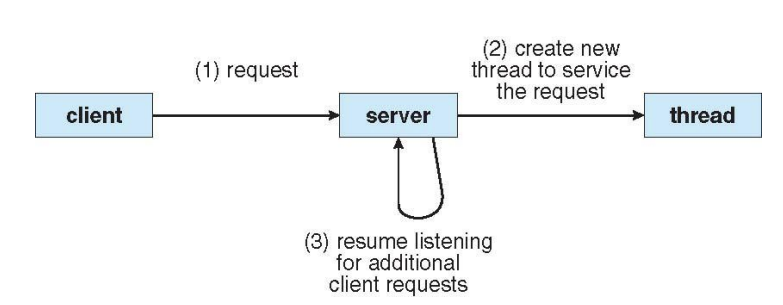
Threads
- Process is an executing program with a single thread of control
-
Modern OS allows for a process to contain multiple threads of control
- A thread (or lightweight process) is a basic unit of CPU utilization; it consists of:
- Thread ID, program counter
- register set
- stack space
- A thread shares with its peer threads its: (시험)
- code section
- data section
- operating-system resources such as open files and signals
- A traditional or heavyweight process is equal to a task with one thread
Multiple Threads within a Task
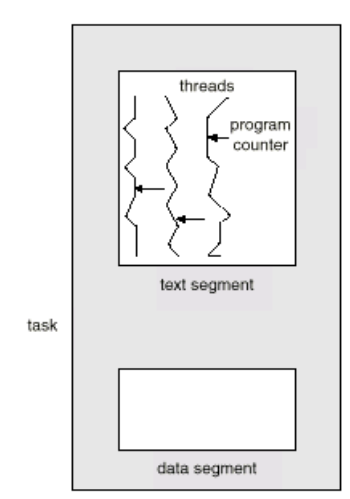
- In a multiple threaded task, while one server thread is blocked and waiting, a second thread in the same task can run.
- Cooperation of multiple threads in same job confers higher throughput and improved performance.
- Applications that require sharing a common buffer (i.e., producer-consumer) benefit from thread utilization.
- Threads provide a mechanism that allows sequential processes to make blocking system calls(ex. syscall) while also achieving parallelism.
Single and Multithreaded Processes
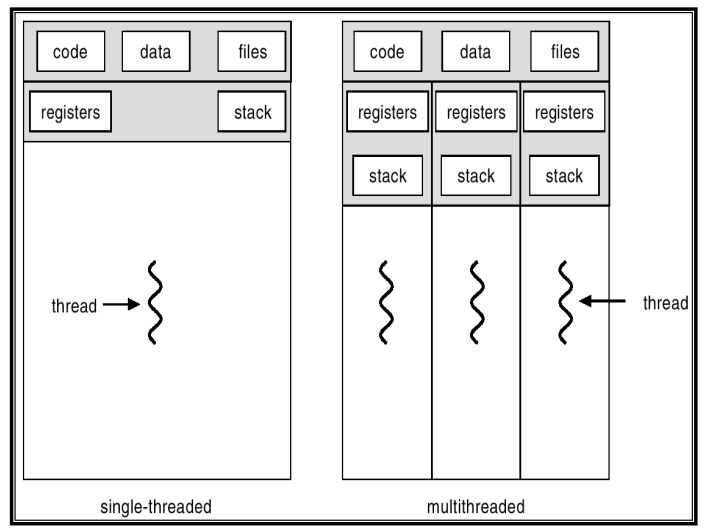
- code, data, files는 여러 프로세스가 생겨도 공유된다.
- 하지만 각 프로세스 별로 실행되는 내용은 다르기 때문에 registers와 stack은 따로 따로 갖게 된다.(시험)
Benefits of multithreaded programming
- Responsiveness (시험)
- Allow a program to continue running even if part of it is blocked or is performing a lengthy operation
- Multithreaded web browser allow user interaction in one thread while an image is being loaded in another thread
- Resource Sharing
- Threads share the memory and resources of the process
- threads share resources of process, easier than shared memory or message passing
- Threads make IPC easier
- Code sharing allows an application to have several threads within same address space
- Economy
- Allocating resources for process creation is costly
- More economical to create and context switch threads (resource sharing)
- In solaris 2, creating process is about 30 times slower than is creating a thread, context switching is about 5 times slower
- Scalability
- process can take advantage of multiprocessor architectures Utilization of MP Architectures
- Benefits of multiprogramming can be greatly increased in MP architecture, where each thread may be running in parallel on a different processor
- A single threaded process can only run on one CPU, no matter how many are available
- Multithreading on a multi-CPU machine increases concurrency
- In a single-processor architecture, the CPU moves between each thread as to create an illusion of parallelism, but in reality only one thread is running at a time (pseduo parallel)
Thread of control 이 1개라면
① ② ③ ④
=> 와 같이 도는데 (1번이 실행되는 동안 아래는 실행이 안 됨)
Thread of control 이 많다면
① ② ③ ④
=> 와 같이 돌 수 있다. (concurrency 보장)
- 사용자 입장에서 1번을 실행하면서 다른 2,3,4,번도 실행되는게 눈에 보임
Multicore Programming
- Single CPU -> multi CPU -> multi-core CPU on single CPU chip
- Each core appears as a separate CPU to OS (4core -> OS가 보기에 4CPU)
- Multi-threaded programming can provide Improved concurrency on multi-core system
- Concurrency means Parallelism
- a system can perform more than one task simultaneosly
- Concurrnecy means pseudo-parallelism
- supports more than one task making progress (계속해서 진전이 이루어진다는 점)
- Single processor / core, (OS)scheduler providing concurrency
- Concurrency means Parallelism
- Multicore systems putting pressure on programmers, challenges include:
- Dividing activities - identify task that can run in parallel on individual core.
- Each task should be independent to be executed on parallel
- Balance (한 core가 너무 많은 하지 않도록 load를 골고루 분배하는 것)
- Data splitting
- Data dependency - when one task depends on data from another, execution of tasks should be synchronized to accommodate data dependency
- Testing and debugging
- Dividing activities - identify task that can run in parallel on individual core.
-
Parallelism implies a system can perform more than one task simultaneously
- Types of parallelism
- Data parallelism - distributes subsets of the same data across multiple cores, same operation on each (시험)
- 1부터 100을 더하라고 했다면 학생1은 1~10까지 더하고 학생2는 11~20까지 더하는 예와 같음
- core가 실행하는 프로그램은 같은데 수행하는 데이터가 다르다
- Task parallelism - distributing threads across cores, each thread performing unique operation
- 같은 데이터에 대해서 다른 task를 수행하는
- Data parallelism - distributes subsets of the same data across multiple cores, same operation on each (시험)
- As # of threads grows, so does architectural support for threading
- CPUs have cores as well as hardware threads
- Consider Oracle SPARC T4 with 8 cores, and 8 hardware threads per core (OS관점 64개 CPU가 있다고 생각)

Concurrency vs. Parallelism
- Concurrent execution on single-core system:
- Parallelism on a multi-core system:
Amdahl’s Law
- Identifies performance gains from adding additional cores to an application that has both serial and parallel components
- S is serial portion (병렬 불가능한 것의 비율)
- 1-S is 병렬할 수 있는
- N processing cores

-
I.e. if application is 75% parallel / 25% serial, moving from 1 to 2 cores results in speedup of 1.6 times, 2.28 times with 4 cores
-
N = 1: speedup = 1
- No speedup
-
N = 2: speedup = 1.6
-
As N approaches infinity, speedup approaches 1 / S
- if 50% serial, max speedup is 2.0
Serial portion of an application has disproportionate effect on performance gained by adding additional cores
-
But does the law take into account contemporary multicore systems?!!!!!!!! (시험)
User Threads and Kernel Threads
- User threads - management done by user-level threads library
- No kernel support
- Three primary thread libraries:
- POSIX Pthreads
- Windows threads
- Java threads
- Kernel threads - Supported by the Kernel(OS)
- Examples – virtually all general purpose operating systems, including:
- Windows
- Solaris
- Linux
- Tru64 UNIX
- Mac OS X
User Level Threads
- Thread management done by user-level threads library
- Three primary thread libraries:
- POSIX Pthreads
- Win32 threads
- Java threads
- supported above the kernel, via a set of thread library calls at the user level (Project Andrew from CMU).
- The library supports for thread creation, scheduling in user space with no kernel support
- Kernel is unaware of user-level threads, so fast
- Drawbacks
- If the kernel is single threaded, then any user-level thread performing a blocking system call will cause the entire process to block, even if other threads are available to run within the application
- Drawbacks
Kernel Threads
- Kernel-supported Threads Supports for threads is provided by OS
- The kernel performs thread creation, scheduling in kernel space
- 단점: Generally slower to manage threads than user thread
- 장점: But, if a thread performs a blocking system call, the kernel can schedule another thread for execution
- In MP environment, the kernel can schedule threads on different processors
- Examples – virtually all general purpose operating systems, including:
- Windows XP/2000, Solaris, Linux, Tru64 UNIX, Mac OS X
- Hybrid approach implements both user-level and kernel-supported threads (Solaris 2).
- Java thread on JVM
User Thread와 Kernel Thread가 다른 점
- User thread는 thread library에 의해 thread가 관리되지만 Kernel thread는 OS에 의해 관리된다.
- 스레드가 blocking system call을 수행할 때 User thread는 전체 process가 block되지만 Kernel thread는 또실행 중인 다른 스레드를 스케줄링 할 수 있다.
Multithreading Models
-
Many systems provide support both user and kernel threads, resulting in different multithreading models
- Many-to-One
- One-to-One
- Many-to-Many
Multithreading Models
Many-to-One
- Many user-level thread mapped to single kernel thread.
- 오직 하나의 kernel thread에 맵핑!
- Thread management is done in user space, so efficient
- 커널 부담이 없는 것이 장점
- Because only one thread can access the kernel at a time, multiple threads are unable to run in parallel on MPs (시험)
- Multiple threads may not run in parallel on muticore system because only one may be in kernel at a time
- Allows the developer to create as many user threads, however, true concurrency is not gained because kernel can schedule only one thread at a time
- Overhead - but entire process will block if a thread makes a blocking system call
- One thread blocking causes all to block
- Used on systems that do not support kernel threads (user-level thread libraries) – Few systems currently use this model
- Examples:
- Solaris Green Threads
- GNU Portable Threads
Multithreading Models: Many-to-One Model
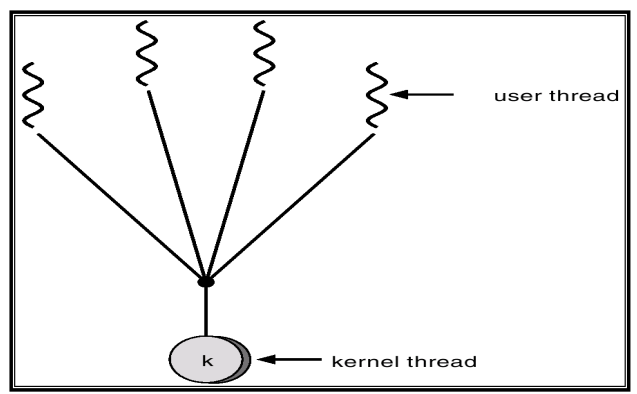
- 4개의 thread 중 어느 thread가 실행되기 위해서 하나의 kernel thread에 할당이 되어야 한다.
- 그러면 kernel은 하나가 돌든 두개가 돌든 전체의 user thread를 하나의 thread로 간주하게 된다.
- kernel thread가 하나의 single thread이면 위의 4개의 user thread 중 하나만 block이 되더라도 나머지가 다 block이 되어 버리게 되는 문제가 있을 수 있다.
One-to-one Model
-
many-to-one보다 concurrency가 극대화
- Each user-level thread maps to kernel thread.
- Creating a user-level thread creates a kernel thread
- provides more concurrency than many-to-one model by allowing another thread to run when a thread makes a blocking system call or by allowing multiple threads to run in parallel (concurrently) on MPs
- Disadv.
- -> creating a user thread requires creating the corresponding kernel thread,
- 커널의 부담이 크다. user level thread의 갯수만큼 thread of control을 요구한다.
- -> Number of threads per process sometimes restricted due to overhead
- 그 갯수를 지원해 주는데 한계가 있기 때문에 mapping이 불가능한 경우가 생길 수 있다.
- -> creating a user thread requires creating the corresponding kernel thread,
- Examples
- Windows NT/XP/2000, Linux, Solaris 9 and later, OS/2
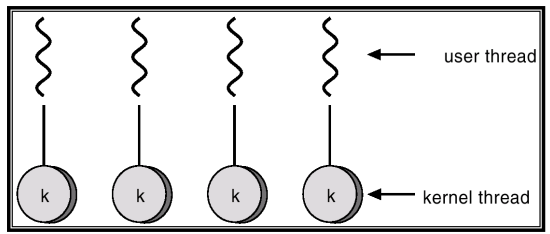
Many-to-Many Model
- one-to-one과 many-to-many의 장단점을 섞은 model
- ono-to-one을 쓰고 싶은데 여기서 커널의 부담을 줄이는
- Allows many user level threads to be mapped to a smaller or equal number of kernel threads.
- 유저의 모든 thread를 받아들이는 것이 아니라 kernel의 입장에서 무리가 가지 않는 수만큼의 thread를 지원.
- 작거나 같은 숫자만큼만.
- 유저의 모든 thread를 받아들이는 것이 아니라 kernel의 입장에서 무리가 가지 않는 수만큼의 thread를 지원.
- Allows the operating system to create a sufficient number of kernel threads.
- In
many-to-one model, true concurrency is not gained because kernel can schedule only one thread at a time - One-to-one model allows greater concurrency, but, overhead of creating kernel threads can burden the performance of an application
- Solaris prior to version 9
- Windows NT/2000 with the ThreadFiber package
- Solaris 2, IRIX, HP-UX, True64 Unix
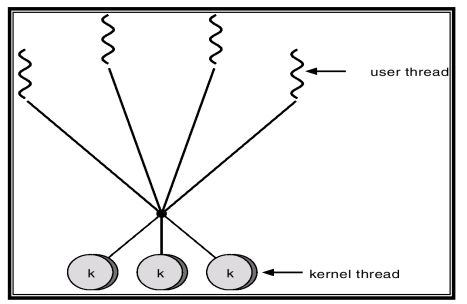
Two-level Model
- many-to-one + one-to-one
- Similar to M:M, except that it allows a user thread to be bound to kernel thread
- 중요한 thread는 100% mapping을 보장시켜주고 나머지 중요하지 않은 thread는 many-to-one으로 mapping
- Examples
- IRIX
- HP-UX
- Tru64 UNIX
- Solaris 8 and earlier

Thread Libraries
- Thread library provides programmer with API for creating and managing threads
- Two primary ways of implementing
- Library entirely in user space
- Kernel-level library supported by the OS
Pthreads
- May be provided either as user-level or kernel-level
- A POSIX standard (IEEE 1003.1c) API for thread creation and synchronization
- A specification for thread behavior, not an implementation
- API specifies behavior of the thread library, implementation is up to development of the library.
-
Common in UNIX operating systems (Solaris, Linux, Mac OS X)
- 유저레벨에도 가능, 커널레벨에도 가능
- pthreads는 인터페이스는 맞추지만, 구현상은 알아서 하라고 하는 것 => 규격. input, output, 와꾸만 맞추는 것
Pthreads Example
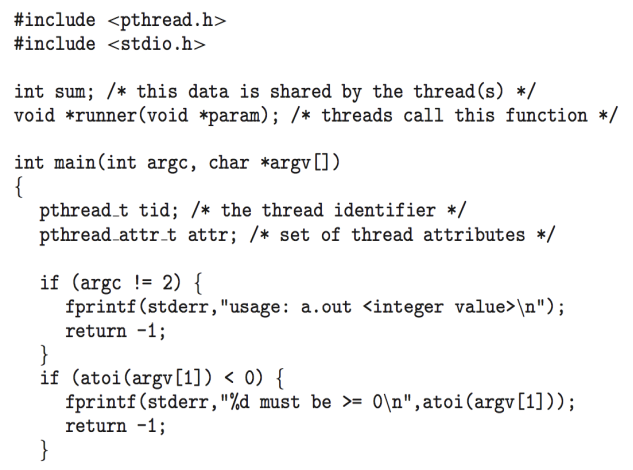
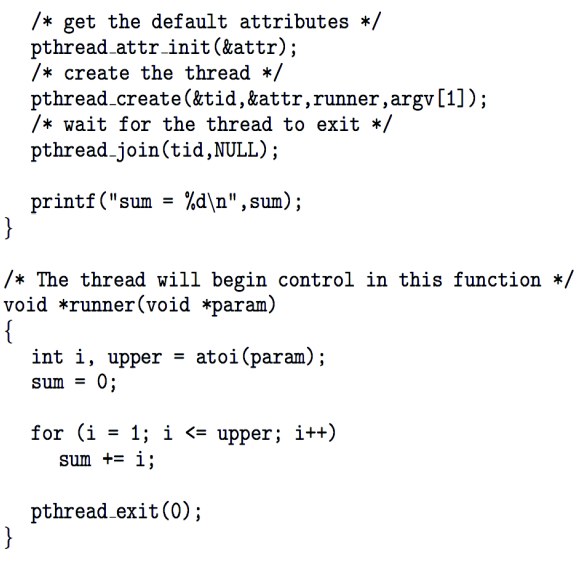
-
pthread_create: fork()와 유사한
-
pthread_join: wait()과 유사한
-
OS가 제공하는 system call과 / 구현을 누가했냐의 차이지 같은 개념이다.
- pthread_attr : attribute를 표현한 자료구조
- pthread_attr_init(&attr) => attribute를 default 값으로 설정해줘
- pthread_create() : &tid -> 여기에 스레드 아이디 좀 써줘 (받는 것)
- &attr : 스레드에게 attr 값들을 넘겨주는 것 (주는 것)
- runner : 함수 -> 실제로 도는 함수
- argv[1] : 넘겨주는 param
- pthread_join() : wait()와 기본적으로 같지만, 이건 library가 제공하는 API
- wait()는 System call
- pthread_exit() : library가 제공하는 API
- exit() : System call
- 하는 일은 같다
(시험) 코드 돌려보기
Pthreads Code for Joining 10 Threads
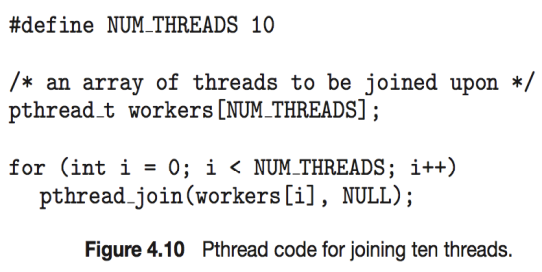
Win32 API Multithreaded C Program
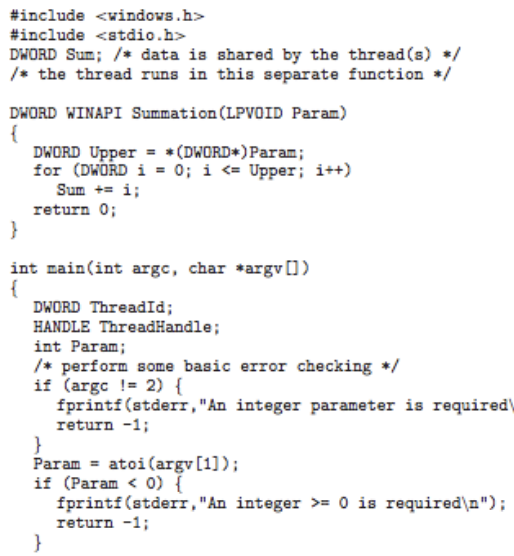
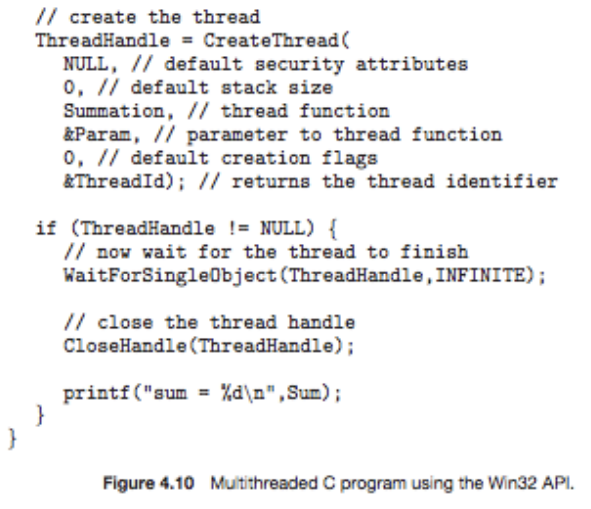
- CreateThread
- WaitForSingleObject
Java Threads
- Most PL(Programming Language) do not enable programmers to specify concurrent activities except Ada
- Generally concurrency has been implemented as OS primitives
- C , C++ programs can perform multithreading by using platform-specific code libraries
- Java provide supports at the language level
- threads are managed by the JVM not by user library or kernel.
- 자바는 JVM에 의해 관리되기 때문에 kernel이나 library에 종속적이지 않다.
- 그러나 OS에 의해 실행되기 때문에 JVM 자체는 하나의 kernel thread로 mapping 되기 때문에 종속적이다.
- Typically implemented using the threads model provided by underlying OS
- Java threads may be created by: (시험 X)
- (1) Extending Thread class - creating a new class that is derived from the Thread class, and to override the run method of the Thread class
- (2) Implementing the Runnable interface

Multi-threaded program for Summation of a non-negative integer
class Summation extends Thread
{
public Summation (int n) {
upper = n;
}
public void run ( ) {
int sum = 0;
if ( upper > 0 ) {
for ( int i = 1; i <= upper; i++)
sum += i ;
}
System.out.println (“the sum of “+upper+” is “ +sum);
}
private int upper;
}
class Summation extends Thread
{
public Summation (int n) {
upper = n;
}
public void run ( ) {
int sum = 0;
if ( upper > 0 ) {
for ( int i = 1; i <= upper; i++)
sum += i ;
}
System.out.println (“the sum of “+upper+” is “ +sum);
}
private int upper;
}
public class ThreadTester
{
public static void main (String[] args){
if (args.length > 0){
Summation thrd = new Summation (Integer.parseInt (args[0]));
thrd.start(); //create thread//
}
else
System.err.println("usage: Summation <integer value>");
}
}
- start method
- Allocates memory and initializes a new thread in JVM
- Calls run method, making the thread eligible to be run by JVM
Multiple threads
public class ThreadTester {
Public static void main ( String [ ] args ) {
PrintThread thread1 = new PrintThread ( “thread1” );
PrintThread thread2 = new PrintThread ( “thread2” );
PrintThread thread3 = new PrintThread ( “thread3” );
System.err.println ("starting threads");
thread1.start( ); thread2.start( ); thread3.start( );
System.err.println (“threads started, main ends \n” threads” );
}
}
class PrintThread extends Thread {
private int sleepTime;
public PrintThread ( String name ){
super (name);
sleepTime = (int) (math.random() * 5001 );
}
public void run ( ) {
try {System.err.println (getName() + “going to sleep for ” + sleepTime);
Threads.sleep (sleepTime);
};
System.err.println (getName() + “done sleeping ” );
}
객체를 여러개 만듦.
Java Multithreaded Program (Runnable Interface 구현상속)

Java Multithreaded Program (Cont.)

Java Thread States
- Blocked : waiting (wait) -> notify, notifyall, T/O interrupt
- sleeping (sleep) -> sleep interval expire interupt
- blocked (io, synch) -> i/o complete, lock acqusition interrupt
- Runnable: ready -> running : thread dispatch
- running -> ready : quantum expire, yield
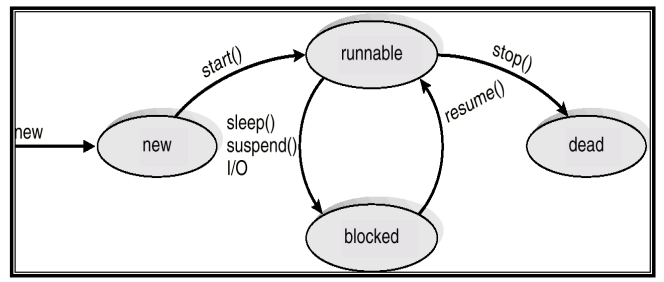
스레드 상태와 생명 주기

- RUNNABLE
- 준비(process state 중 ready state)
- 실행 중(process state 중 running state)
- WAITING과 BLOCK이 구분되어 있음
- process에서는 I/O든 interrupt 든 wating으로 묶었음
- 다른 thread가 notify 메소드를 호출하여 waiting thread를 깨운다.
JVM & Host OS
- JVM is on top of a host OS
- Allows the JVM to hide the implementation details of underlying OS
- Provide a consistent, abstract environment that allows java programs to operate on any platform that supports a JVM
- JAVA spec. does not specify how java threads are to be mapped to OS
- Windows 95/98/NT/2000 use one-to-one model - each java thread for a JVM maps to a kernel thread
- Solaris 2 implements JVM as many-to-one model
- With Solaris 2.6, JVM was implemented using many-to-many model
Linux Thread States
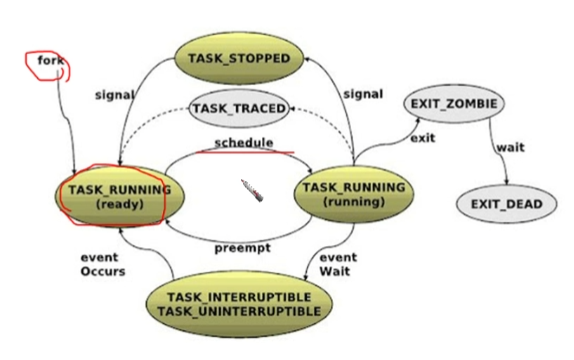
running 상태에서 일정 시간 이상 머물게 되면 강제로 ready state로 보낸다.(뒷장에서 배울 preemption)
Implicit Threading
-
스레드의 관리를 컴파일러나 Run-time library가 관리를 하고, 어플리케이션 개발자들이 이런 걸 신경 쓰지 않게 하기 위함
- Growing in popularity as numbers of threads increase, program correctness more difficult with explicit threads
- 버그를 찾는 것이 어려워짐
- explicit threads: 프로그램을 작성한 사용자가 직접 실행한 thread
- Creation and management of threads done by compilers and run-time libraries rather than programmers
- -> implicit thread
- 개발자들이 따로 명시하지 않아도 사실 스레드가 진행되고 있어서 Implicit Threading임
- Three methods explored (아래에서 이에 대한 자세한 설명이 나오는데 이는 시험 X)
- Thread Pools
- OpenMP
- Grand Central Dispatch
- Other methods include Microsoft Threading Building Blocks (TBB), java.util.concurrent package
Thread Pools
- Create a number of threads in a pool where they await work - thread 그릇은 사전에 만들어 놓는 것
- Advantages:
- Usually slightly faster to service a request with an existing thread than create a new thread
- Allows the number of threads in the application(s) to be bound to the size of the pool
- Separating
task to be performed from mechanics of creating taskallows different strategies for running task- i.e.Tasks could be scheduled to run periodically
- Windows API supports thread pools:

OpenMP
- Set of compiler directives and an API for C, C++, FORTRAN
- Provides support for parallel programming in shared-memory environments
- Identifies parallel regions – blocks of code that can run in parallel
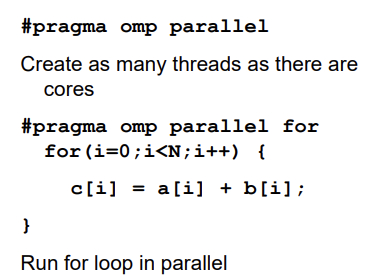

Grand Central Dispatch
- Apple technology for Mac OS X and iOS operating systems
- Extensions to C, C++ languages, API, and run-time library
- Allows identification of parallel sections
- Manages most of the details of threading
- Block is in
“^{ }”- ex)
ˆ{ printf("I am a block"); }
- ex)
- Blocks placed in dispatch queue
- Assigned to available thread in thread pool when removed from queue
- Two types of dispatch queues:
- serial – blocks removed in FIFO order, queue is per process, called main queue
- Programmers can create additional serial queues within program
- concurrent – removed in FIFO order but several may be removed at a time
- serial – blocks removed in FIFO order, queue is per process, called main queue

Threading Issues
- Semantics of fork() and exec() system calls.
- 둘이 같은가 다른가?
- Thread cancellation.
- Asynchronous or deferred
- Signal handling
- Synchronous and asynchronous
- Thread pools
- Thread specific data
- Create Facility needed for data private to thread
- 데이터지만 스레드 간에 공유하지 않는 데이터의 issue
- Scheduler activations
fork() and exec() system calls
- In a multithreaded program, the semantics of fork, exec change
- Does fork() duplicate only the calling thread or all threads?
- fork는 프로세스를 만들어내는 것인데 fork를 하는 경우 그 안의 존재하는 모든 thread를 복제해야 하는가?
- If one thread in a program calls fork, does the new process duplicate all threads or is the new process single-threaded ?
- Unix has 2 versions
- One that duplicates all threads
- Another that duplicates only the thread that invoked fork
- Exec() usually works as normal – replace the running process including all threads (process 동작과 거의 동일)
- If a thread invokes the exec system call, the program specified in the parameter to exec will replace the entire process (all threads)
- 코드 자체는 공유되기 때문에
- exec()을 호출하냐 안하냐에 따라 달라짐
- 호출하면 주소공간이 바뀌기 때문에 어차피 바꿀건데 뭐하러 모든 스레드를 복사함?
- 호출하지 않으면 그냥 그대로 모든 스레드를 복제하는 것이다.
Thread cancellation (1/2)
-
abort() 느낌
- Task of terminating a thread before it has completed
- Ex) multiple threads are concurrently searching through a DB and one thread returns the result.
- A thread that is to be cancelled is referred to as target thread
- 예를 들어 DB 검색을 목적으로 멀티스레드를 만들었다면,, DB의 여러 섹션을 스레드마다 검색. => 한 스레드가 원하는 데이터를 찾았다!! -> 나머지 스레드들을 종료시켜야 한다. ==> 아! 이래서 필요하구나!!
- Two general approaches:
- Asynchronous cancellation -> one thread immediately terminates the target thread
- 자원 반납할 여유도 없이 terminate, 왜 죽는 지도 모르고 즉사
- Deferred cancellation -> the target thread can periodically check if it should terminate, allowing the target thread an opportunity to terminate itself in an orderly fashion
- Flag checking
- 자원 반납(뒷정리)을 스스로하게 될 여유를 줌.
- ex) cleanup routine
- target thread가 자신이 주기적으로 내가 죽어야 되나 말아야 되나를 체크
- 죽어야 된다고 판단 시 스스로 종료
- Asynchronous cancellation -> one thread immediately terminates the target thread
- Pthread code to create and cancel a thread:
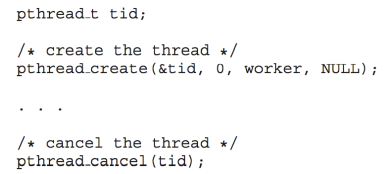
- Invoking thread cancellation requests cancellation, but actual cancellation depends on thread state

- If thread has cancellation disabled, cancellation remains pending until thread enables it
- Default type is deferred (연기된, 뒷정리를 하고 죽는)
- Cancellation only occurs when thread reaches cancellation point
- 반드시 cancellation point가 정의 되어 있어야 함.
- I.e. pthread_testcancel()
- Then cleanup handler is invoked
- Cancellation only occurs when thread reaches cancellation point
-
On Linux systems, thread cancellation is handled through signals
- How about the resources that are allocated to the thread?
- If a thread was cancelled while in the middle of updating data it is sharing with other threads?
- With asynchronous cancellation, OS may not free a system-wide resource
- With synchronous cancellation, cancellation points should be defined
Signal handling (1/3)
-
A signal is used to notify a process that a particular event has occurred
- A signal is generated by the occurrence of a particular event
- A generated signal is delivered to a process
-
Once delivered, the signal must be handled by one of two signal handlers:
- default
- user-defined
-
Delivery of signal can be done either synchronously or asynchronously
- Synch: illegal memory access, division by zero
- signal is delivered to the same process that performed the operation causing the signal
- Asynch: generated by an event external to a running process
- Terminating a process ctrl + c
- Typically asynchronous signals are sent to another process
- Synch: illegal memory access, division by zero
Signal handling (2/3)
- Every signal may be handled by
- A default signal handler
- A user-defined handler (우선 순위가 더 높음)
- Every signal has a default signal handler that is run by the kernel
- The default signal handler is overridden by a user-defined signal handler
- user defined signal handler가 있다면 ! default 무시 -> user defined 실행
- Handling signals in single-threaded programs is straightforward
- Signals are always delivered to a process
Signal handling (3/3)
- Where then should a signal be delivered for multi-threaded?
- Deliver the signal to the thread to which the signal applies
- Synchronous signal
- 직접적 연결이 있는 thread에 signal 전달하는
- Deliver the signal to every thread in the process
- Asynchronous signal such as c
- Deliver the signal to certain threads in the process
- Some unix allows a thread to specify which signals it will accept or and which it will block
- Delivered only to the first thread found in a process that is not blocking the signal
- Assign a specific thread to receive all signals for the process
- Solaris 2
- Deliver the signal to the thread to which the signal applies
- Window 2000 : asynchronous procedure call (APC)
- Allows a user thread to specify a function that is to be called when the user thread receives notification of a particular event
- Similar to asynchronous signal
Overlapped 모델(II)
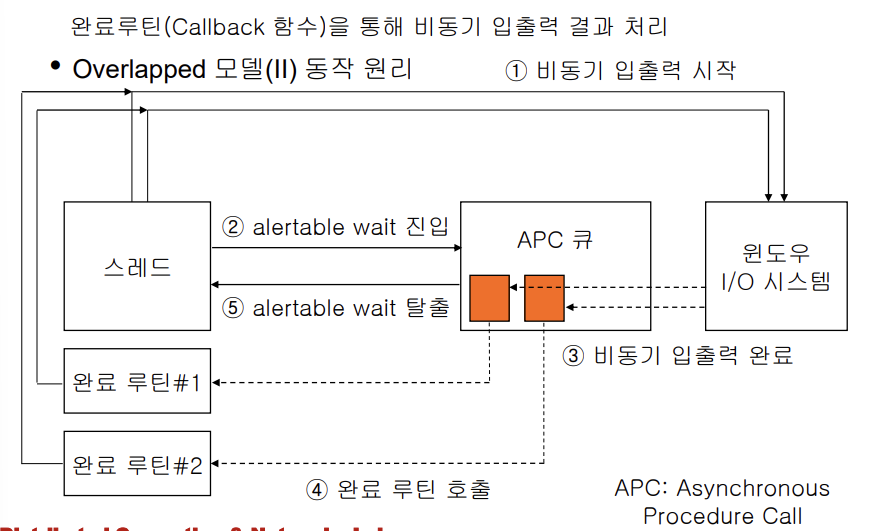
Thread pools
- Scenario of multithreading a web server
- Creating a separate thread is superior to separate process
- But, it also has problems
- Time required to create the thread
- 프로세스보다(fork()) 시간이 적게 걸리지만 스레드 생성에 시간이 오래 걸림
- Unlimited thread creation could exhaust system resources
- 클라이언트의 요구가 몇 개가 들어올 지 모름
- Time required to create the thread
- Create a number of threads at process startup and place them in pool
- Advantages:
- Usually slightly faster to service a request with an existing thread than create a new thread
- Allows the number of threads in the application(s) to be bound to the size of the pool
- 스레드가 할 일을 다 하면 죽는 것이 아니라 다시 thread pool로 돌아가는 것
Thread-specific data (Thread-Local Storage)
-
멀티스레드에서 한 프로세스 내의 모든 스레드는 메모리를 공유한다!! 하지만, 각 스레드는 자기 고유의 데이터가 필요하다.
- Threads belonging to a process share the data of the process
- Benefits of multithreaded programming
- However, 때때로, each thread might need its own copy of certain data
- Allows each thread to have its own copy of data
- Thread-local storage (TLS) allows each thread to have its own copy of data
- Most thread libraries provide the thread-specific data
- Win32, Pthreads, Java
- Useful when you do not have control over the thread creation process (i.e., when using a thread pool)
- Different from local variables
- Local variables visible only during single function invocation
- TLS visible across function invocations (함수 호출 ~ 리턴까지); 함수가 종료해도 남아있음
- Similar to static data in C
- TLS is unique to each thread
Scheduler Activations(시험)
- Both M:M and Two-level models require communication to maintain the appropriate number of kernel threads allocated to the application
- Typically use an intermediate(중간) data structure between user and kernel threads - lightweight process (LWP)
- Appears to be a virtual processor on which process can schedule user thread to run
- Each LWP attached to kernel thread
- How many LWPs to create?
- Scheduler activations provide upcalls - a communication mechanism from the kernel to the thread library
- upcall: 커널에서 스레드 라이브러리에 전달하는 통신 메커니즘
- 몇 개 필요한지 물어봐서 그 갯수에 해당하는 커널 스레드를 만들거나 회수해 준다.
- upcall: 커널에서 스레드 라이브러리에 전달하는 통신 메커니즘
- This communication allows an application to maintain the correct number kernel threads
- 즉, 커널 스레드 개수를 동적으로 control
- 로드가 적을 때는 개수를 적게, 로드가 많을 때는 개수가 많게
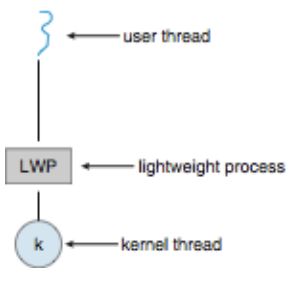
Threads Support in Solaris 2
- Solaris 2 is a version of UNIX with support for threads at the kernel and user levels, symmetric multiprocessing, and real-time scheduling.
- Implements many-to-many model Implements the Pthread API, UI threads
- User level threads with a library containing APIs for thread creation and management
- Developers opt for Pthread library
Threads Support in Solaris 2
- LWP – intermediate level between user-level threads and kernel-level threads.
- Each process contains at least one LWP
- Thread library multiplexes user-level threads on the pool of LWPs for the process
- Only user-level threads currently connected to an LWP accomplish work
- The rest one are either blocked or waiting for an LWP on which they can run
- Kernel-level thread
- Each LWP has an kernel-level thread
- Some kernel-level threads run on the kernel’s behalf and have no associated LWP (a thread to service disk request)
- The only objects scheduled for CPU
- User-level threads may be either bound or unbound
- A bound thread
- permanently attached to an LWP
- Runs on the LWP, and by request the LWP can be dedicated to a single processor
- Binding a thread is useful in situations that require quick response time, such as real-time app.
- An unbound thread (default)
- is not permanently attached to an LWP
- All unbound threads in an application are multiplexed onto the pool of available LWPS for the application
Solaris 2 Threads
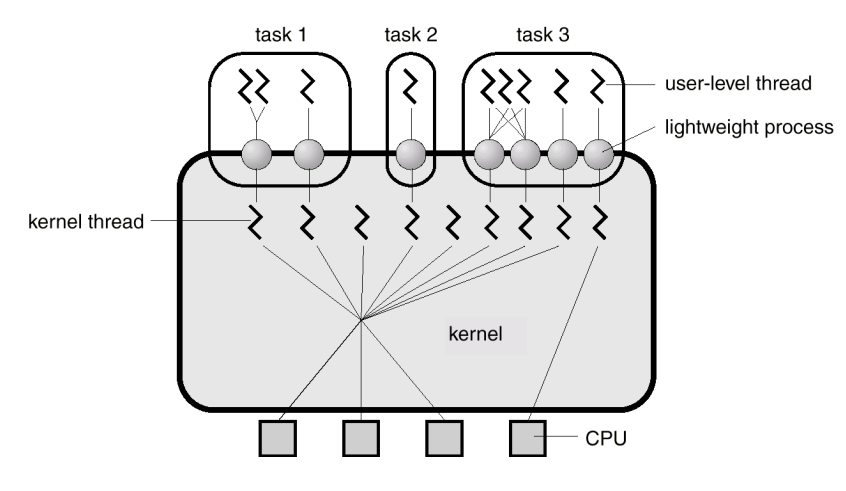
Data structures to implement threads on Solaris 2
- Kernel thread:
- small data structure and a stack
- Copy of kernel registers
- A pointer to LWP to which it is attached
- A priority
- LWP: kernel data structures
- register set for the user-level thread it is running
- accounting and memory information
- switching between LWPs is relatively slow.
- User-level thread: exists in user space
- Thread ID, register set including PC and SP
- Stack, priority for scheduling
- no kernel involvement means fast switching.
Solaris 2 Process
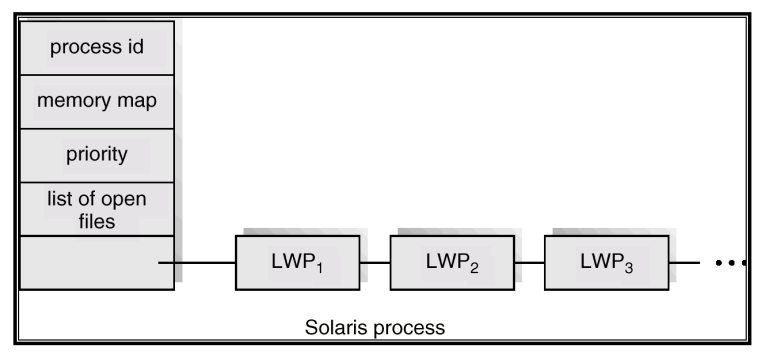
Windows Threads
- Windows implements the Windows API – primary API for Win 98, Win NT, Win 2000, Win XP, and Win 7
- Implements the one-to-one mapping, kernel-level
- Each user-level thread maps to an associated kernel thread
- Each thread contains
- a thread id
- register set representing state of processor
- separate user and kernel stacks for when thread runs in user mode or kernel mode
- private data storage area used by run-time library and dynamic link libraries (DLLs)
- The register set, stacks, and private storage area are known as the context of the threads
- The primary data structures of a thread include:
- ETHREAD (executive thread block) – includes pointer to process to which thread belongs and to KTHREAD, in kernel space
- KTHREAD (kernel thread block) – scheduling and synchronization info, kernel-mode stack, pointer to TEB, in kernel space
- TEB (thread environment block) - thread id, user-mode stack, thread-local storage, in user space
Windows XP Threads Data Structures
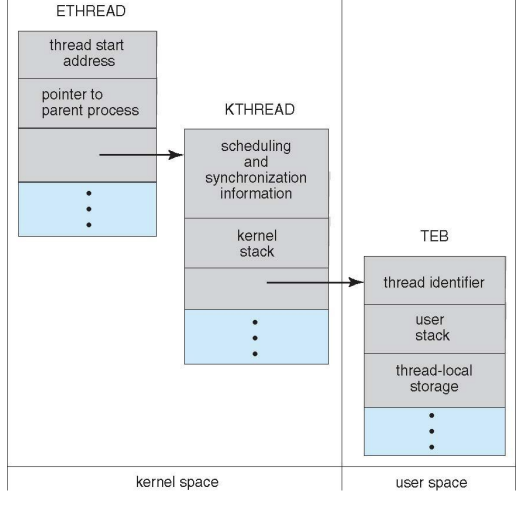
윈도우
프로세스와 스레드 (1/2)
- 용어
- 프로세스(process)
- 메모리를 비롯한 각종 리소스를 담고 있는 컨테이너(container)로서 정적인 개념
- 스레드(thread)
- 실제 CPU 시간을 할당받아 수행되는 실행 단위로서 동적인 개념
- 주 스레드(primary thread)
- main() 또는 WinMain() 함수에서 시작되는 스레드로, 프로세스가 시작할 때 생성
- 컨텍스트 전환(context switch)
- CPU와 운영체제의 협동으로 이루어지는 스레드 실행 상태의 저장과 복원 작업
- 프로세스(process)
프로세스와 스레드 (2/2)

Process와 Thread
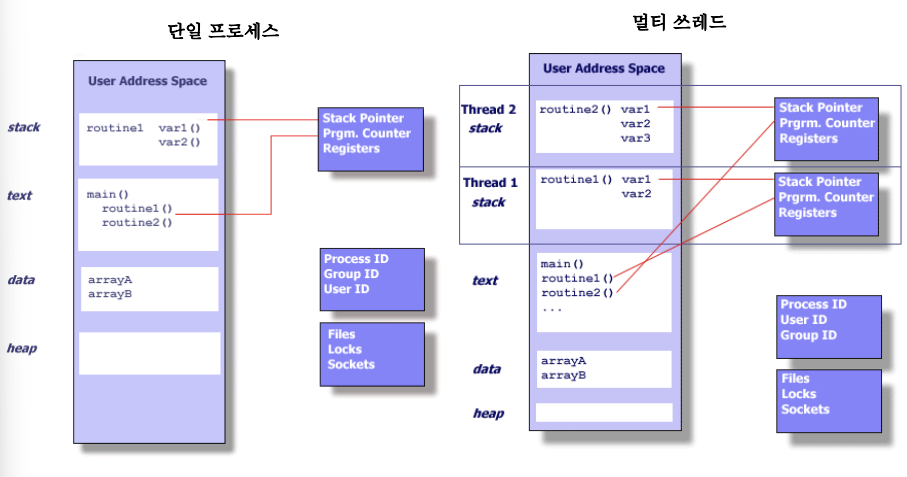
- thread마다 stack에 대한 정보가 복제된다.
- 스택만 별도로 복제, 다른 건 공유
스레드 생성과 종료 (1/6)
- 스레드 생성에 필요한 요소
- 스레드 함수(thread function)의 시작 주소
- 스레드 함수 실행시 사용할 스택 영역의 크기
스레드 생성과 종료 (2/6)
- 프로세스의 주소 공간
- 두 개의 함수
- 세 개의 스레드
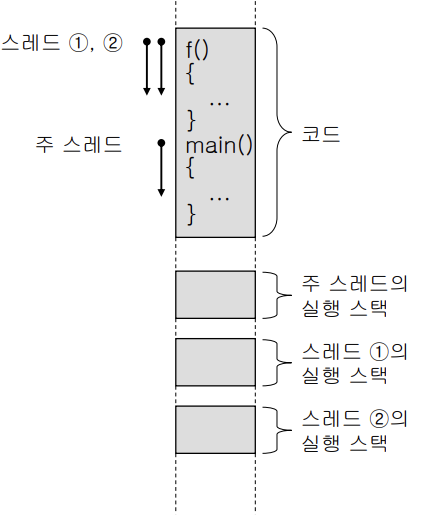
- main 함수의 thread - primary thread
스레드 생성과 종료 (3/6)
- CreateThread() 함수 (API)
- 스레드를 생성한 후 스레드 핸들(thread handle)을 리턴
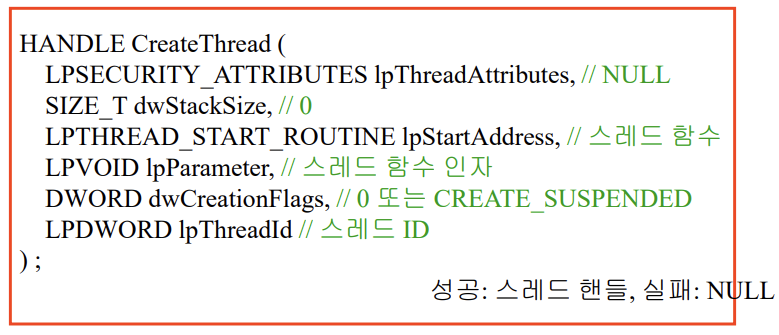
스레드 생성과 종료 (4/6)
- 스레드 함수 정의

스레드 생성과 종료 (5/6)
-
스레드 종료 방법 (4가지 경우)
① 스레드 함수가 리턴
② 스레드 함수 내에서 ExitThread() 함수를 호출
- exit()
③ TerminateThread() 함수를 호출
- kill(), abort()
④ 주 스레드가 종료하면 모든 스레드가 종료
스레드 생성과 종료 (6/6)
- 스레드 종료 함수
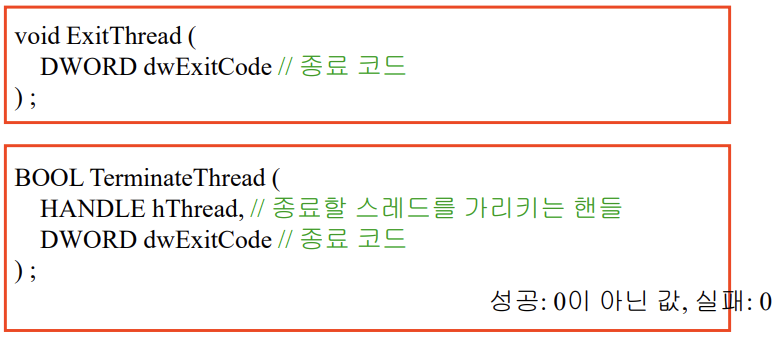
#include <windows.h>
struct Point3D
{
int x, y, z;
};
DWORD WINAPI MyThread(LPVOID arg)
{
Point3D *pt = (Point3D *)arg;
while(1){
printf("Running another thread: %d, %d, %d\n",
pt->x, pt->y, pt->z);
Sleep(1000);
}
return 0;
}
int main()
{
// 첫 번째 스레드 생성
Point3D pt1 = {10, 20, 30};
DWORD ThreadId1;
HANDLE hThread1 = CreateThread(NULL, 0, MyThread,
(LPVOID)&pt1, 0, &ThreadId1);
if(hThread1 == NULL) return -1;
CloseHandle(hThread1);
// 두 번째 스레드 생성
Point3D pt2 = {40, 50, 60};
DWORD ThreadId2;
HANDLE hThread2 = CreateThread(NULL, 0, MyThread,
(LPVOID)&pt2, 0, &ThreadId2);
if(hThread2 == NULL) return -1;
CloseHandle(hThread2);
while(1){ //무한루프
printf("Running primary thread...\n");
Sleep(1000);
}
return 0;
}
main thread, T1, T2 총 세 thread가 실행 중임
Linux Threads
thread냐 process냐는 공유정보가 무엇인가에 따라 달라진다.
- Linux refers to them as tasks rather than threads
struct task_structpoints to process data structures (shared or unique)-
Linux provides a fork system call with the traditional functionality of duplicating a process
- Thread creation is done through clone() system call.
- clone behaves much like fork, except that instead of creating a copy of the calling process, it creates a separate process that shares the address space of the calling process
- A cloned task behaves like a separate thread
- clone() allows a child task to share the address space of the parent task (process)
- In case of clone, Sharing of address space is allowed because of
- Rather than storing kernel data for each process’s data structure, it stores pointers to data structures of other process
- Linux refers to both of process and thread as tasks
- Aside from the cloned process, Linux does not support multithreading, separate data structures.
- Pthread implementations are available for user-level multithreading
Linux Threads
fork()andclone()system calls- Doesn’t distinguish between process and thread
- Uses term task rather than thread
clone()takes options to determine sharing on process createstruct task_structpoints to process data structures (shared or unique)
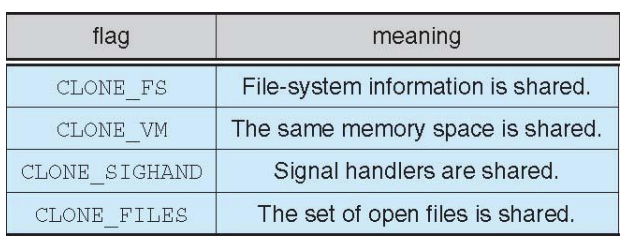


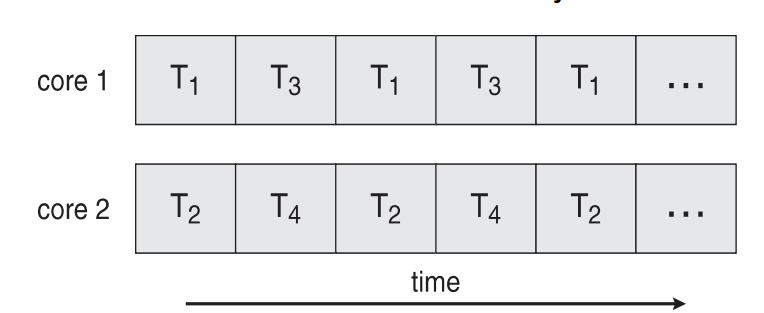
댓글남기기